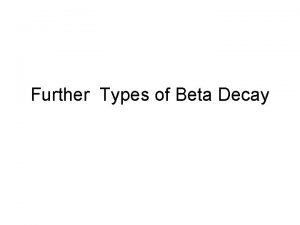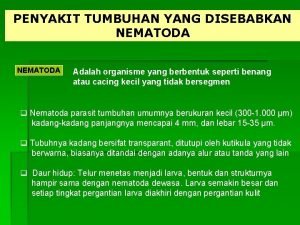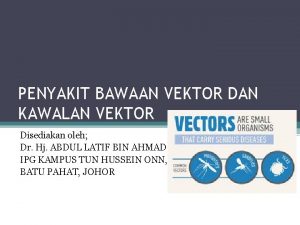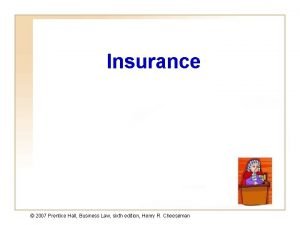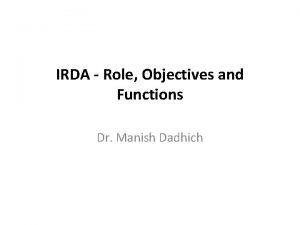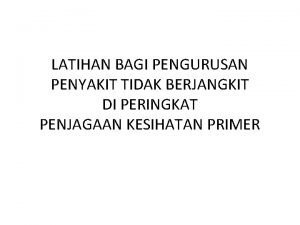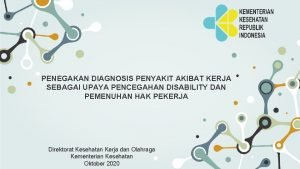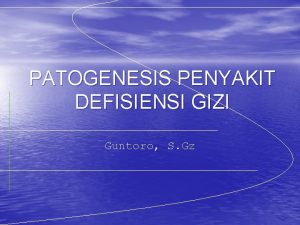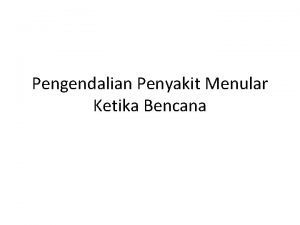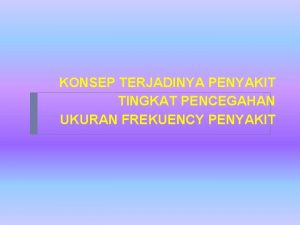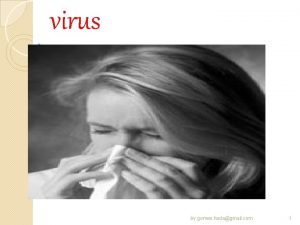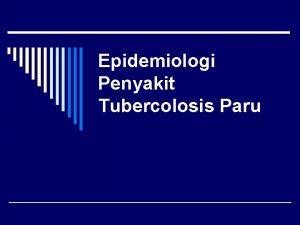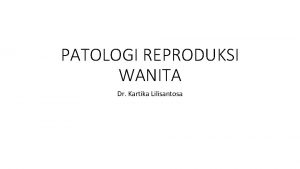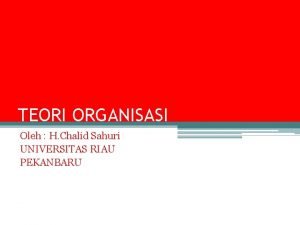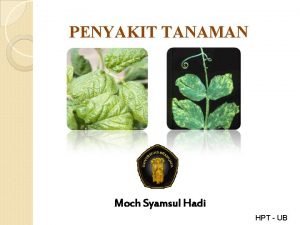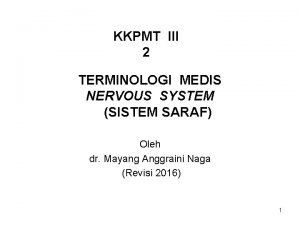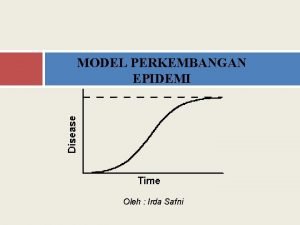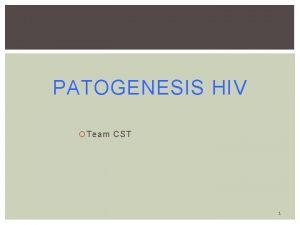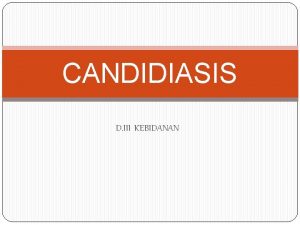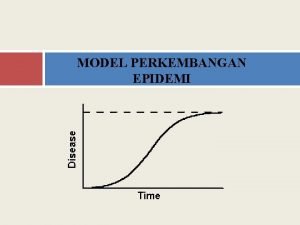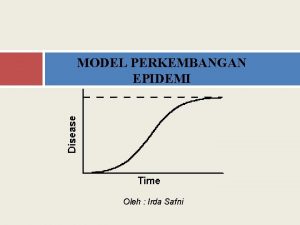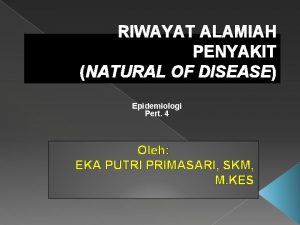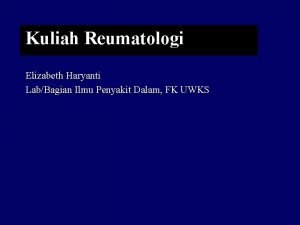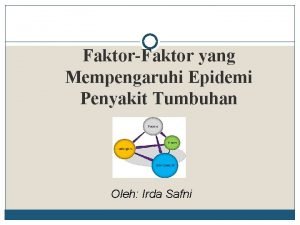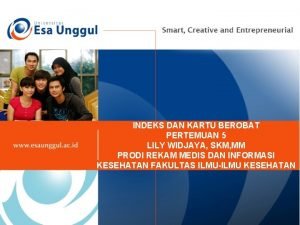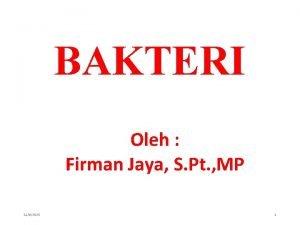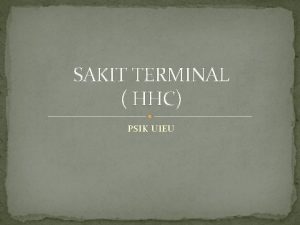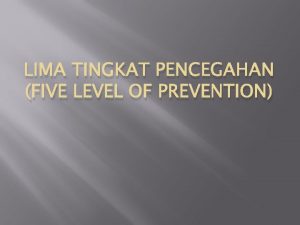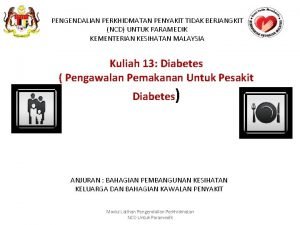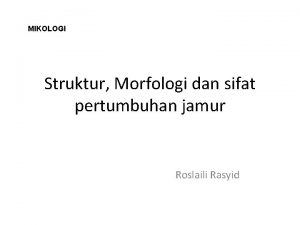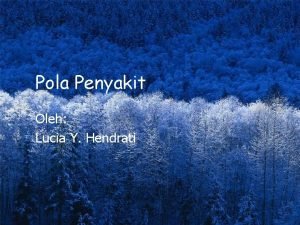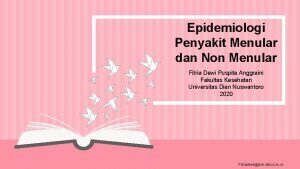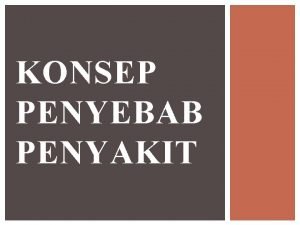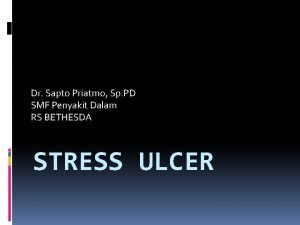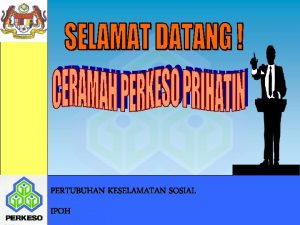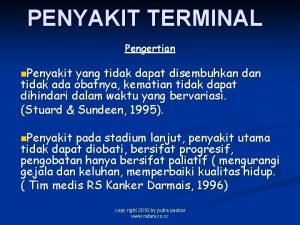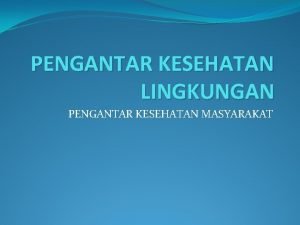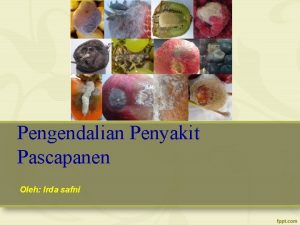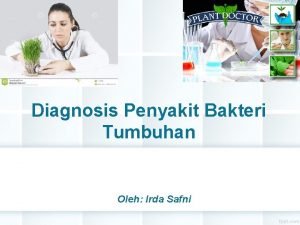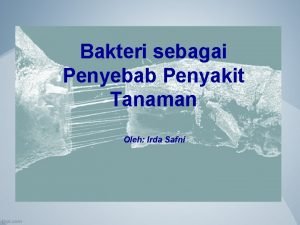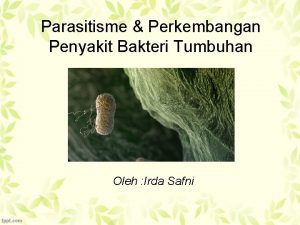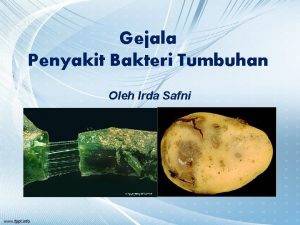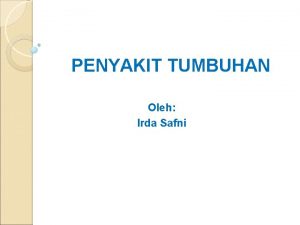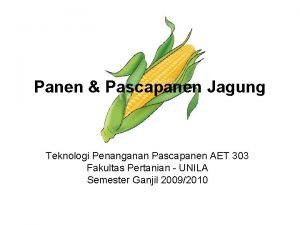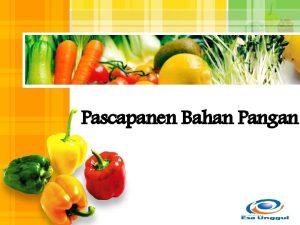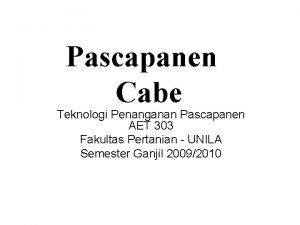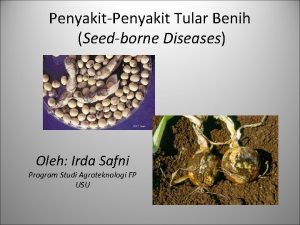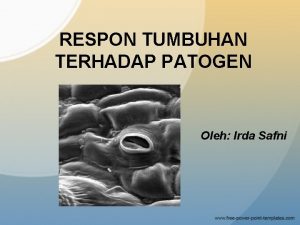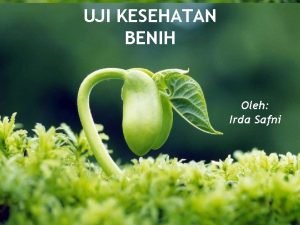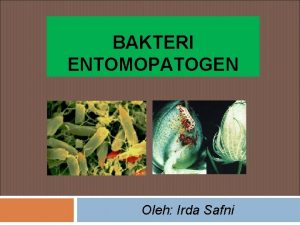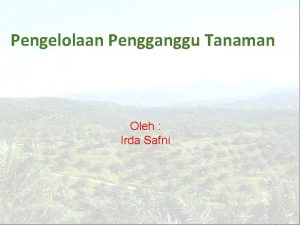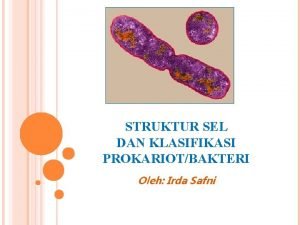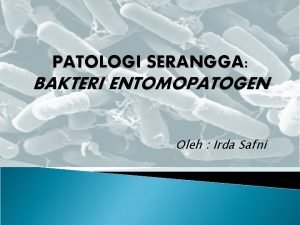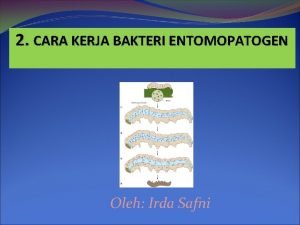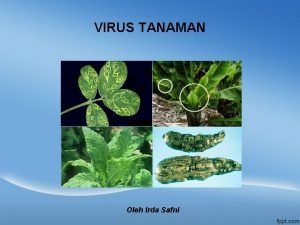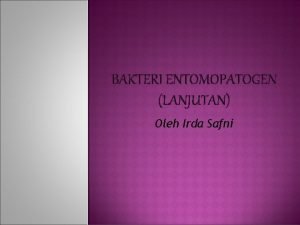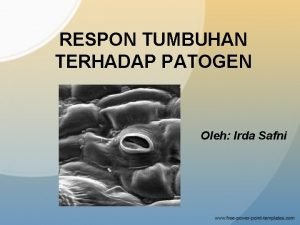Pengendalian Penyakit Pascapanen Oleh Irda Safni Postharvest decay



















































- Slides: 51

Pengendalian Penyakit Pascapanen Oleh: Irda Safni

Postharvest decay organisms Fungi (eukaryotic organisms): • Most important • Mostly members of the Ascomycetes and Fungi imperfecti • Propagation and dissemination by abundantly produced, mostly asexual spores • Infection through wounds or sometimes through intact fruit surface. Bacteria (prokaryotic organisms): • Mostly pathogens of vegetables • Pectobacterium carotovorum is the most important postharvest pathogen causing a soft rot. • Infections only through wounds.

Major postharvest decays of pome fruits Gray mold decay of Bosc and Asian pear caused by Botrytis cinerea Penicillium decay of Bosc pear caused by Penicillium expansum Alternaria decay of Asian pear caused by Alternaria sp. Anthracnose of apple caused by Colletotrichum acutatum

Postharvest decays of stone fruits Brown rot (Monilinia fructicola) Gray mold (Botrytis cinerea) Rhizopus rot (Rhizopus stolonifer) Sour rot (Geotrichum candidum) Brown rot Infection through wounds and of healthy tissues Gray mold Infection through wounds and of senescent tissues Sour rot Infection through wounds of ripe fruit Rhizopus rot Infection through wounds

Postharvest decays of citrus Green mold caused by Penicillium digitatum (most important on citrus) Blue mold caused by P. italicum and mold green Penicillium spp. are wound pathogens Penicillium soilage Brown rot caused by Phytophthora spp. Infection through intact tissue.

Major postharvest decays of citrus Sour rot caused by Geotrichum citri-aurantii Tear stain and anthracnose caused by Colletotrichum gloeosporioides Alternaria decay caused by Alternaria sp. Stem end rot caused by Lasiodiplodia theobromae (B. rhodina)

Postharvest decays of pomegranates and kiwifruit Gray mold caused by Botrytis cinerea Infection through flower parts Infection through cut stem ends at harvest

Major postharvest decays of tomato Gray mold Decay caused by Botrytis cinerea Sour rot Rhizopus rot Geotrichum candidum R. stolonifer Infection through wounds of ripe fruit

Postharvest decay organisms Penetration through wounds – Wound pathogens: • Most common • Only minor wounds required (micro-wounds). • Wounds commonly occur before harvest (insect injuries, wind damage, etc. ) or more frequently during and after harvest during handling, transport, packaging. • Goal in postharvest handling: Minimize fruit injuries. Penetration of intact fruit: • Through surface of mature fruit. • Quiescent infections that are established early during fruit growth but remain inactive until the fruit matures. • Colonization of flower parts, invasion of maturing fruit

Infection by postharvest decay fungi Conidiophore and conidia (asexual spores) of Botrytis Spore germination: requires water, cinerea oxygen, and sometimes nutrients Host infection: Penetration (through wounds or directly), inter- and intracellular growth. Enzymatic activities dissolve host cell walls and contents. Sometimes production of toxins that kill host cells.

Physiology, optimum harvest date Conducive parameters during storage, transportation, marketing Identification, biology, ecology

Principles of Plant Disease Management • Preventative (population) – Avoidance of the pathogen (Cultural practices) – Host resistance (Resistant varieties) – Exclusion (Quarantines and Sorting/Grading)* – Eradication (Eliminating or reducing inoculum - Sanitation)* – Protection/Prevention (Chemical or biological or physical treatments – Cold temperature)* • Curative (individual) – Therapy (Physical or chemical treatments) * - Main postharvest practices for susceptible crop.

Preventative Practices - Eradication Sanitation washes using oxidizing materials (chlorine, ozone, peroxide, etc. ) Disinfestation of non-injured commodity surfaces and of micro-organisms in water Micro-organisms in stem punctures, pits, injuries, natural cracks, or bruises, residual activity H No Yes E P

Comparison between postharvest sanitation and fungicide treatments Treatment Delivery System Sources Activity Advantages Disadvantages Chlorine Water Gas or liquid (Cl 2 or Na. OCL) Fruit surface/In solution Inexpensive, effective at low rates Sensitive to p. H and organic load; corrosive; reactive Chlorine dioxide Water On-site generation Fruit surface/In solution Less sensitive to organic load Initial cost of equipment; corrosive; training Ozone Water (low solubility)/ Air On-site generation In solution, but poor solubility; Air: antisporulation Non-chlorine based, no disposal issues Poor water solubility, initial cost of equipment; corrosive; training Acidified hydrogen peroxide Water Liquid (H 2 O 2) Fruit surface/In solution; some wound activity Less sensitive to organic load and p. H, no disposal issues Conc. limits, cost, some sensitivity to Cl, p. H, and organic load Postharvest fungicide (e. g. , Scholar) Water Dry or liquid Formulation Wound protection Highly effective Residues; safety concerns; export tolerances (MRLs)

Chlorination in a hydrocooler (re-circulating) Chlorination on a brush bed (non-re-circulating) Critical factors Concentration Contact time p. H Organic load Temperature Concentration Contact time p. H

Preventative Practices Strategies of postharvest decay control for protection, suppression, or eradication of decay Altering the micro-environment H Treatments with indirect effects on pathogen: Change in p. H E Treatments with direct effects on pathogen: Biocontrols: Competition, antibiosis, parasitism Fungicides: Direct toxicity P Altering the host physiology and susceptibility Indirect effect on pathogen Plant growth regulators (PGRs) Gibberellin (citrus) 2, 4 -D (citrus) Ethylene biosynthesis inhibitors? Effective against weak pathogens H E P Disease triangle

Altering the micro-environment Treatments with indirect effects on the pathogen: Disease H E triangle Change in p. H Alkaline solutions of borax, sodium carbonate (soda ash), and sodium bicarbonate Accumulation of acid in potential infection sites, (e. g. SO 2) Treatments with direct effects on pathogen: Biocontrols: Competition, antibiosis, parasitism Fungicides: Direct toxicity P

Borax, sodium carbonate (soda ash), and sodium bicarbonate Change in p. H Accumulation of alkali in potential infection sites on fruit surface Germination of pathogen spores is inhibited (fungistatic action) Heated solutions are more toxic Disadvantages Change in p. H is gradually reversed by acid H fruit juice Fruit staining Fruit dehydration P E No residual activity Disease triangle

Usage of borax, sodium carbonate (soda ash), and sodium bicarbonate in postharvest treatments of lemons Wash with chlorine and detergent Direction of fruit movement soda ash tank

Usage of borax, sodium carbonate (soda ash), and sodium bicarbonate in postharvest treatments of lemons Treatment with heated soda ash Water rinse after soda ash treatment

Altering the micro-environment Treatments with indirect effects on the pathogen: Change in p. H Alkaline solutions of borax, sodium carbonate, and sodium bicarbonate Treatments with direct effects on pathogen: Biocontrols: Competition, antibiosis, parasitism Fungicides: Direct toxicity H E P

Biocontrols: Competition, antibiosis, parasitism Development is driven by safety concerns Activity from laboratory experiments is difficult to transfer into a commercial scale No activity against existing infections (infections that occur at harvest) Efficacy is generally inconsistent and never complete Previously, 2 products registered: - Aspire (no longer manufactured), see NEXY (Candida oleophila) - Bio-Save (Pseudomonas syringae), still in use

The biocontrol Bio-Save is registered for postharvest use

Spectrum of Activity of Biocontrols for Postharvest Decay Control Biocontrol Organism Bacteria Pseudomonas syringae Crops Apples, pears, citrus Sweet cherry Yeast Candida oleophila Decays Penicillium Decays Gray mold, Penicillium decays Pome fruit Penicillium Decays Citrus Penicillium Decays

Biocontrol products registered in other countries • Yield. Plus (Cryptococcus albidus) – developed in South Africa for pome fruit • Avogreen (Bacillus subtilis) – South Africa for avocado • Shemer (Metschnikowia fructicola) – Israel for apricot, peach, citrus, grapes, pepper, strawberry, sweet potato • Several other products such as Candifruit (Candida sake), NEXY (Candida oleophila), and Boni-Protect (Aureobasidium pullulans) are in development.

Postharvest treatments approved for organic produce and their limitations • Sodium bicarbonate • Calcium chloride and other chlorine products (with their rates defined by OMRI) • Diluted ethanol (not in the US) • Heat - Short-lived - Only water and surfacedisinfestation • UV irradiation • Biocontrol agents - Cost, damaging to some crops - Inconsistent - Highly regulated by government - Cost, damaging to some crops

Prevention, suppression, and eradiction of postharvest decays Fungicides vs. biological controls Fungicides Single synthetic active ingredient Well characterized chemically and toxicologically Efficacy generally high Biological controls Mixtures of active and inactive ingredients. Active ingredient often unknown. Chemically and toxicologically often poorly characterized, but considered natural. Efficacy variable

Development of Fungicides for Management of Plant Diseases Initially, developed as simple elements or organic compounds that are non-systemic in plant tissue, and have a low-resistance potential to target organisms. . . but over time, they have been developed as more complex organic compounds, that may be systemic in plant tissue, and have a high-resistance potential to target organisms.

Fungicides have a specific spectrum of activity and, in most cases, are suitable for a limited number of crops

Classes of postharvest fungicides Compounds within each fungicide class have: Similar chemical structures A similar mode of action that targets either a single site or multiple sites in the biochemical pathways of the fungus Cross-resistance may occur among compounds within the same chemical class

Important older postharvest fungicides for citrus and pome fruits that are still being used today Residual Fungicide Class/Grouping Crops Decays SOPP Phenol Penicillium decay, sour rot Thiabendazole Benzimidazole Imazalil SBI-Imidazole Citrus, pome fruit Citrus Penicillium decay, gray mold Penicillium Decays

Towards safer postharvest decay control materialsof older pesticides Re-registration requirements Reduced Risk Pesticides (an EPA Classification) A relative term that is applied to a pesticide as compared to currently registered pesticides of a crop group. A pesticide that broadens the adoption of IPM practices or reduces: - Exposure risk to humans - Potential toxicity to non-target organisms - Contamination of the environment Primarily reduced-risk fungicides will be registered for postharvest use in the US

Benefits of postharvest reduced-risk fungicides to prevent decay Untreated and postharvest treated (Scholar) peaches and sweet cherries

Spectrum of Activity of Registered and New Postharvest Fungicides on Selected Agricultural Crops in the US Fungicide Tebuconazol e Class Crops Decays SBI-Triazole Sweet cherry Brown rot, Rhizopus, and Mucor decays Fludioxonil Phenylpyrrole Azoxystrobin Qo. I Fenhexamid Hydroxyanilide Pyrimethanil Anilinopyrimidine Stone fruit*, pome fruit* Pomegran. *, kiwifruit* citrus, Pineapple, tuber crops Citrus potato Stone fruit, pomegranate, kiwifruit Stone fruit, pome fruit, citrus Difenoconazole SBI-Triazole Pome fruit, tuber crops Propiconazole SBI-Triazole Stone fruit, citrus, tomato, pepper Brown rot, gray mold, Rhizopus Rot, Penicillium decays Brown rot, gray mold Penicillium decays, brown rot, gray mold Penicillium decays, Bull’s eye rot Rhizopus rot Penicillium decays, brown rot, gray mold, sour rot Fungicide is already registered; * - FAT approved in Japan. new registrations or proposals are in bold italics

Application methods for postharvest fungicide treatments High-volume spray application ('T-Jet')

Application methods for postharvest fungicide treatments Low-volume spray application (Controlled droplet application - CDA)

Application methods for postharvest fungicide treatments Dip application

Application methods for postharvest fungicide treatments Flooder application

Application methods for postharvest fungicide treatments Flooder application

Application methods for postharves t fungicide treatments Fogging

Application of postharvest fungicide treatments Aqueous applications Application in wax-oil emulsions - Not all fruit coatings are considered food-grade in different international markets - Prevention of water loss while still permitting gas exchange - Increase of shine of fruit

Postharvest fungicide treatments as a component of postharvest handling Example: Lemons in California Fruit arrival Sorting Chlorine wash, soda ash treatment, water rinse Application of fungicide and fruit

Storage wax application Bulk packing in bins Storage for up to 3 months Pack wax application Boxing, shipping, marketing

Chlorine wash after storage Boxing and marketing Sorting Fungicide and pack wax application

Use limits of pesticides Residue tolerance: Maximum residue limit or MRL of a chemical that is allowed on a specific commodity. Risk assessment based on: - Toxicological characteristics of chemical - Amount of human consumption of a specific commodity. Note - Actual chemical residues are fractions of the tolerances or

Graduate (fludioxonil) MRLs in major export markets: Lemon Orange Grapefruit Tangerine U S CODEX 10 10 7 10 10 10 7 EU 10 10 5 5 10 1 Korea 10 10 Australia 7 5 5 — Hong Kong India Malaysia New Zealand Philippines Singapore Thailand Japan FAT Taiwan Following CODEX:

Conclusions Chemical treatments in postharvest decay management Maximum efforts have been placed on: Food safety (EPA's 'Reduced-risk' fungicides) - No mammalian activity at registered rates - Lower rates (parts per million quantities) - Specific to target plant pathogens Delivery of high quality nutritious fruits and vegetables with minimal losses to growers, packers, and distributors Development and proper stewardship of integrated management programs cooperatively with land grant research and extension programs and federal/state regulatory agencies.

Use limits of pesticides Residue tolerances must be established for all postharvest chemical treatments except for those that are exempt: - EPA – Exempt designation or - FDA – GRAS (Generally Regarded as Safe) designation Examples for GRAS compounds: chlorine, potassium sorbate, potassium bisulfite, sulfur Residue tolerances - Maximum residue limits (MRLs) = The highest amount of a chemical that is allowed to remain on the fruit – determined by EPA. - Set below the amount that could pose a health concern. - Different for different countries – based on consumer habits and risk analysis Food Additive Tolerances (FATs) – Classification as an ingredient for food use (country specific, e. g. , Japan)

Examples of maximum residue limits (MRLs) - US Fungicide Fludioxonil Fenhexamid Pyrimethanil MRL LD 50 rat Stone fruit: 5 mg/kg >5000 mg/kg Stone fruit: 10 mg/kg >2000 mg/kg Citrus: 7 mg/kg >5000 mg/kg = ppm Remember that these are maximum levels and actual residue levels are just fractions of these values to obtain desired control.

If you are still concerned…. • Wash your fruit! (Most fungicides are not systemic and can be removed with a household rinse)

TERIMA KASIH
 Beta plus decay
Beta plus decay How to find decay factor
How to find decay factor Penyakit tanaman yang disebabkan oleh nematoda
Penyakit tanaman yang disebabkan oleh nematoda Antropod dan penyakit manusia
Antropod dan penyakit manusia Duties of irda
Duties of irda Duties of irda
Duties of irda Irda objectives and functions
Irda objectives and functions Irda complaint
Irda complaint Irda brokers regulations 2018
Irda brokers regulations 2018 Aneosinofilia
Aneosinofilia Penyakit tidak berjangkit
Penyakit tidak berjangkit Langkah diagnosis penyakit akibat kerja
Langkah diagnosis penyakit akibat kerja Patogenesis penyakit defisiensi gizi
Patogenesis penyakit defisiensi gizi Manfaat mengetahui riwayat alamiah penyakit
Manfaat mengetahui riwayat alamiah penyakit Manajemen penanggulangan penyakit menular saat bencana
Manajemen penanggulangan penyakit menular saat bencana Ukuran keganasan bibit penyakit
Ukuran keganasan bibit penyakit Penyakit yang menyerang tumbuhan adalah
Penyakit yang menyerang tumbuhan adalah Riwayat alamiah penyakit tbc
Riwayat alamiah penyakit tbc Penyebab benign neoplasm of breast d24
Penyebab benign neoplasm of breast d24 Penyakit organisasi
Penyakit organisasi Limas penyakit tanaman
Limas penyakit tanaman Disease artinya
Disease artinya Riwayat alamiah penyakit meningitis
Riwayat alamiah penyakit meningitis Contoh penyakit monosiklik
Contoh penyakit monosiklik Rumus keparahan penyakit
Rumus keparahan penyakit Patogenesis hiv
Patogenesis hiv Perléche
Perléche Model perkembangan penyakit
Model perkembangan penyakit Contoh penyakit polisiklik
Contoh penyakit polisiklik Bagan riwayat alamiah penyakit dbd
Bagan riwayat alamiah penyakit dbd Dr elizabeth haryanti
Dr elizabeth haryanti Epidemi penyakit tanaman adalah
Epidemi penyakit tanaman adalah Kartu indeks pasien
Kartu indeks pasien Pengertian riwayat alamiah penyakit
Pengertian riwayat alamiah penyakit Ciri-ciri penyakit sipilis
Ciri-ciri penyakit sipilis Penyakit terminal adalah
Penyakit terminal adalah Penyakit menular seksual
Penyakit menular seksual Ukuran frekuensi penyakit adalah
Ukuran frekuensi penyakit adalah 5 level of prevention adalah
5 level of prevention adalah Makanan untuk pesakit covid
Makanan untuk pesakit covid Jamur candida menyebabkan penyakit
Jamur candida menyebabkan penyakit Pengenalan penyakit unggas
Pengenalan penyakit unggas Konsep keperawatan anak dengan penyakit kronis dan terminal
Konsep keperawatan anak dengan penyakit kronis dan terminal Pola penyakit
Pola penyakit Heremoid
Heremoid Contoh penyakit tidak menular
Contoh penyakit tidak menular Jaring-jaring sebab akibat penyakit tbc
Jaring-jaring sebab akibat penyakit tbc Dr sapto bethesda
Dr sapto bethesda Tarikh bayaran pencen penakat 2021
Tarikh bayaran pencen penakat 2021 Riwayat alamiah penyakit dbd
Riwayat alamiah penyakit dbd Maksud penyakit terminal
Maksud penyakit terminal Teori simpul
Teori simpul
